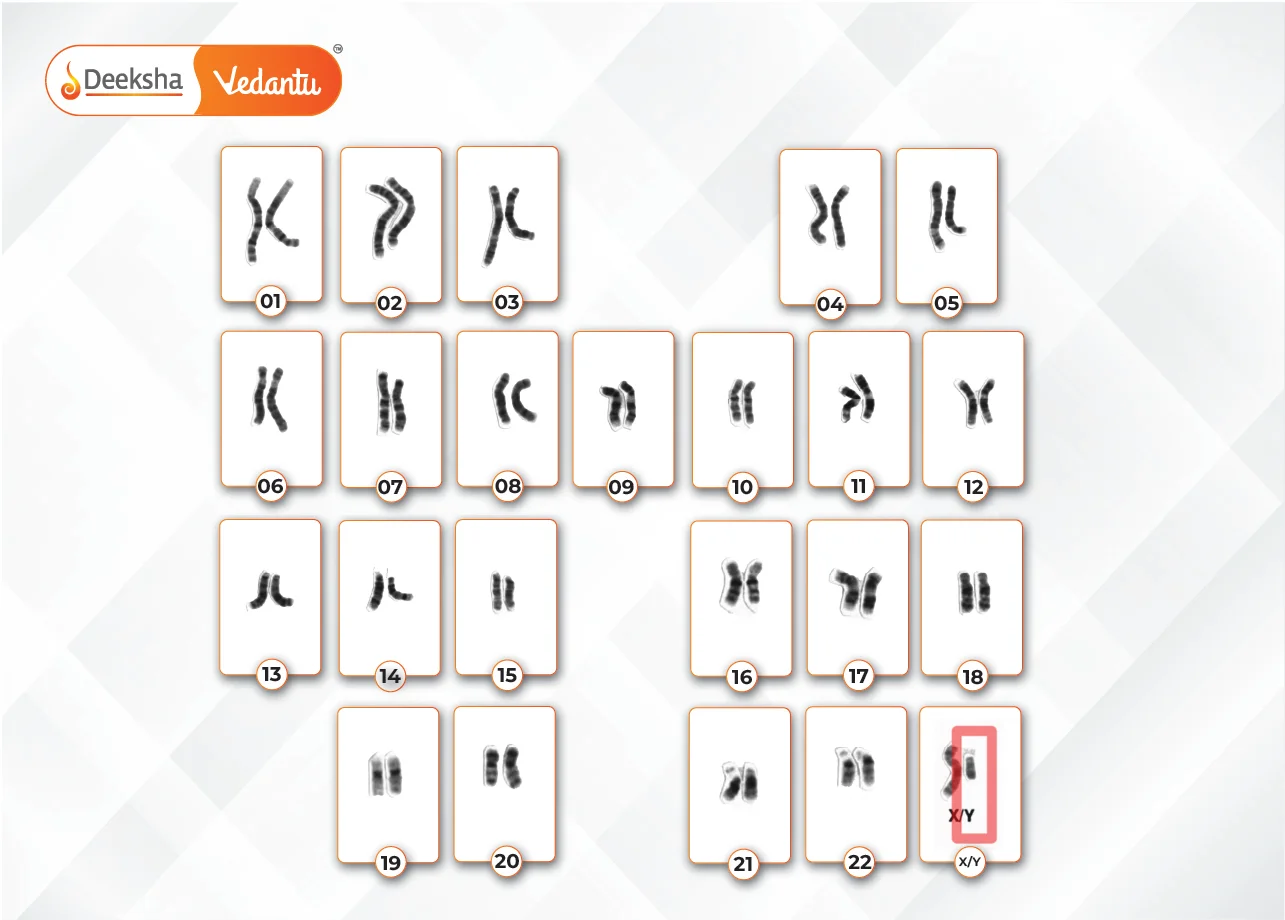What is a Chromosome? – Chromosome Definition
Chromosomes are thread-like structures present in the nucleus, which carry genetic information from one generation to another. They play a vital role in cell division, heredity, variation, mutation, repair, and regeneration. In eukaryotic cells, genetic material is present in the nucleus in chromosomes, which are made up of highly organized DNA molecules with histone proteins supporting their structure.
Chromosome Meaning and Discovery
- Chromosome means ‘coloured body,’ referring to its staining ability by certain dyes.
- Karl Nägeli in 1842 first observed the rod-like structure present in the nucleus of the plant cell.
- W. Waldeyer in 1888 coined the term ‘chromosome’.
- Walter Sutton and Theodor Boveri in 1902 suggested that chromosomes are the physical carriers of genes in eukaryotic cells.
The number of chromosomes in any species is constant for all cells. The number of chromosomes in gametes (e.g., sperm, egg) is half of the somatic cell and is known as a haploid set of chromosomes, which is the result of meiosis during sexual reproduction. Chromosome number is preserved in the mitotic division of somatic cells, which is required for an organism to grow, repair, and regenerate.
Chromosome Number
- Varies in different species.
- Nematode species: 2 chromosomes.
- Protozoan species: up to 1600 chromosomes.
- Most plants and animals: 8 to 50 chromosomes.
- Humans: 23 pairs of chromosomes (2n = 46), with 22 autosomes and 1 sex chromosome.
Karyotyping: A technique to study the structure of chromosomes, useful for identifying chromosomal abnormalities.

Chromosome Structure:

Chromosomes consist of DNA and histone proteins. They are made up of chromatin, containing a single DNA molecule and associated proteins.
Main parts of chromosomes:

- Chromatid: Each chromosome has two symmetrical structures called chromatids or sister chromatids.
- Each chromatid contains a single DNA molecule.
- During anaphase, sister chromatids separate and migrate to opposite poles.
- Centromere and Kinetochore:
- Sister chromatids are joined by the centromere.
- Spindle fibers attach at the centromere during cell division.
- Centromere is called primary constriction.
- The centromere contains a disc-shaped kinetochore, which has specific DNA sequences with special proteins bound to them.
- Secondary Constriction and Nucleolar Organizers:
- Chromosomes may have secondary constrictions.
- Secondary constrictions contain genes to form nucleoli, known as the nucleolar organizer.
- Telomere:
- The terminal part of a chromosome, preventing the fusion of chromosomal segments.
- Satellite:
- An elongated segment sometimes present on a chromosome at the secondary constriction.
- Chromatin:
- Made up of DNA, RNA, and proteins.
- Darkly stained, condensed region of chromatin is known as heterochromatin.
- Light-stained, diffused region of chromatin is known as euchromatin.
Structural Organisation of Chromatin:

- Chromatin consists of DNA and associated proteins.
- Nucleosomes are the basic unit of chromatin.
- DNA is packaged in a highly organized manner in chromosomes.
- Nucleosomes consist of DNA wound around histone proteins.
- Histone proteins play an important role in gene regulation.
Types of Chromosome

- Monocentric: One centromere.
- Holocentric: Diffused centromere.
- Acentric: Chromosome without a centromere.
- Dicentric: Chromosome with two centromeres.
Based on the position of the centromere:
- Telocentric: Centromere at the end.
- Acrocentric: Centromere near one end.
- Submetacentric: Centromere slightly off-center.
- Metacentric: Centromere in the middle.
Giant Chromosomes:

- Polytene Chromosome: Found in some Dipteran insects, with multiple chromonemata.
- Lampbrush Chromosome: Found in oocytes of vertebrates and invertebrates, resembling a brush.
Functions of Chromosomes
- Carry genetic material from one generation to another.
- Guide growth, reproduction, repair, and regeneration.
- Protect DNA from getting tangled and damaged.
- Regulate gene expression.
- Aid in the movement of chromosomes during cell division.
FAQs
Polytene chromosomes are large chromosomes found in some Dipteran insects with multiple chromonemata. Lampbrush chromosomes are found in oocytes of vertebrates and invertebrates, resembling a brush due to their lateral loops.
Karyotyping is a technique used to study the structure of chromosomes and identify chromosomal abnormalities.
Nucleosomes are the basic unit of chromatin, consisting of DNA wound around histone proteins. They help in packaging DNA into a compact structure.
Heterochromatin is a darkly stained, condensed region of chromatin that is genetically inactive. Euchromatin is a light-stained, diffused region of chromatin that contains genetically active, loosely packed DNA.
The centromere joins sister chromatids and is the attachment site for spindle fibers during cell division. It plays a crucial role in the movement of chromosomes.
The main parts of a chromosome include chromatids, centromere, kinetochore, secondary constriction, nucleolar organizer, telomere, and chromatin.
Chromosomes were first observed by Karl Nägeli in 1842. W. Waldeyer coined the term ‘chromosome’ in 1888.
Chromosomes are thread-like structures present in the nucleus that carry genetic information from one generation to another. They play a vital role in cell division, heredity, variation, mutation, repair, and regeneration.











Get Social